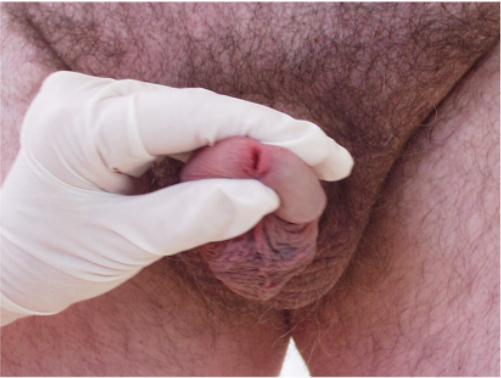|
Examining the Male Genitals
Ask about frequency of urination, including urgency, hesitation,
pain, blood, absence or diminishing amount, pus, color, and dribbling or incontinence; and
check for past or present evidence of sexually transmitted diseases (STD).
|

Male Anatomy

Check for urethral discharge by compressing the meatus between thumb
and forefinger.

Palpate each testicle for enlargement, irregularity or tenderness.

Feel the spermatic cord as it rises from the testicle into the
abdomen.

Using an index finger, probe the inguinal ring. Have the patient
cough, and feel for pulsation and descent of intra-abdominal contents
through the ring and onto the tip of your finger.
|
Scrotum
The scrotum is a cutaneous pouch containing the testes and part of the
spermatic cord. Immediately beneath the skin is a thin layer of muscular fibers
(cremaster), which is controlled by temperature and contracts or relaxes to lower or raise
the testes in relation to the body. This muscular activity of the scrotum is necessary to
regulate the temperature of the testes, which is important in the maturation of sperm
cells.
Testes
The testes are oval glands suspended by the spermatic cord in a pouch. They
perform two functions: production of spermatozoa (sperm) and secretion of the male sex
hormone testosterone.
-
Check by palpating using the thumb and first two fingers.
-
They should feel smooth, rubbery, but free of nodules. Irregularities in texture or size may indicate cyst or tumor.
Lying close to the superior pole of each testis is the epididymus, a ductal
system that collects and transmits sperm from the testes.
Spermatic Cords
The two spermatic cords, each of which suspends and supplies a testis, are
formed by the ductus deferens, arteries, veins, lymphatics, and nerves, bound together by
connective tissue.
-
Palpate it between thumb and forefinger. It should not be
tender, although stretching of the tissues will cause discomfort.
-
Note any swelling or nodules
-
A varicocele, if present, will be felt in this area.
Penis
The penis is composed of three cylindrical bodies of spongy cavernous tissue,
bound together by connective tissue and loosely covered by a layer of skin. Two of the
bodies, the corpora cavernosa, lie superiorly side by side; the third body, the corpus
spongiosum, is median, lying in the groove between the other two. The dilated distal end
of the corpus spongiosum is known as the glans penis. The cavernous tissue becomes greatly
distended with blood during sexual excitement, causing erection of the penis. The loose
skin of the penis folds back on itself at the distal end, forming the prepuce, or
foreskin, and covers the glans. Frequently, the prepuce is surgically removed
(circumcision) to prevent irritation and to facilitate cleanliness.
-
Note if circumcised, if not is the foreskin easy to retract, check the external meatus of the urethra, note any discharge. Palpate the shaft for tenderness or lesions.
-
Look for any ulcers, nodules, or evidence of inflammation
-
Check the pubic hair at the base of the penis for nits or lice.
-
If the patient reports a urethral discharge, but you don't see
anything, strip the urethra, by compressing it at the base of the penis and
milking any secretions up to the glans.
-
Any discharge should ideally be cultured and gram stained.
|
A Brookside
Press Addition to the original Operational Medicine Manual. |
Prostate Gland
The prostate gland is made of smooth muscle and glandular tissue that
surrounds the first part of the urethra. It resembles a chestnut in shape and size. It
secretes an alkaline fluid to keep the sperm mobile and protect it from the acid
secretions of the female vagina. This substance is discharged into the urethra as part of
the ejaculate, or semen, during the sexual act.
Check for hernia:
-
With the patient standing inspect the area of the inguinal canal while he bears down or strains as if having a bowel movement.
-
After inspecting, insert a finger into the lower scrotum.
-
Ask patient to cough.
-
If a hernia is present, you should feel intestine push against your finger.
For further information, read:
Genitourinary
System, in Hospital Corpsman Sickcall Screeners Handbook
Male
Genitalia, in Hospital Corpsman Sickcall Screeners Handbook
|






